
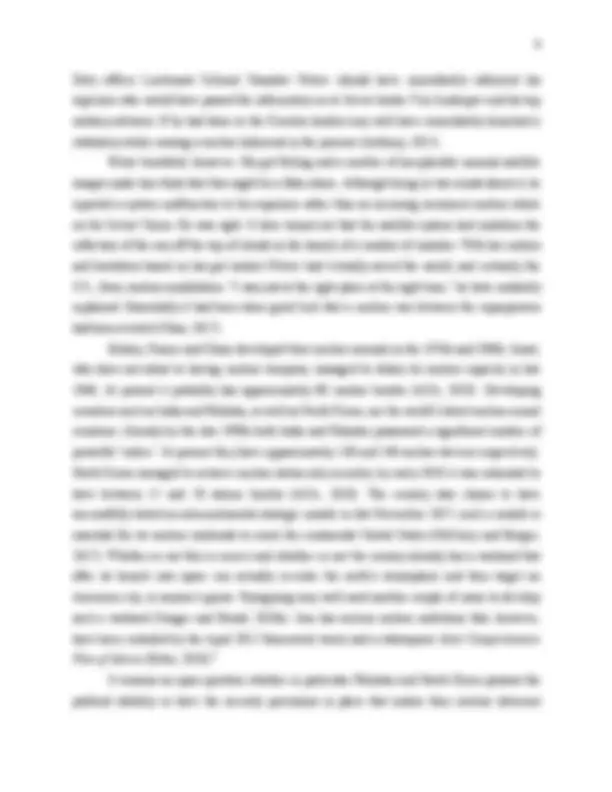
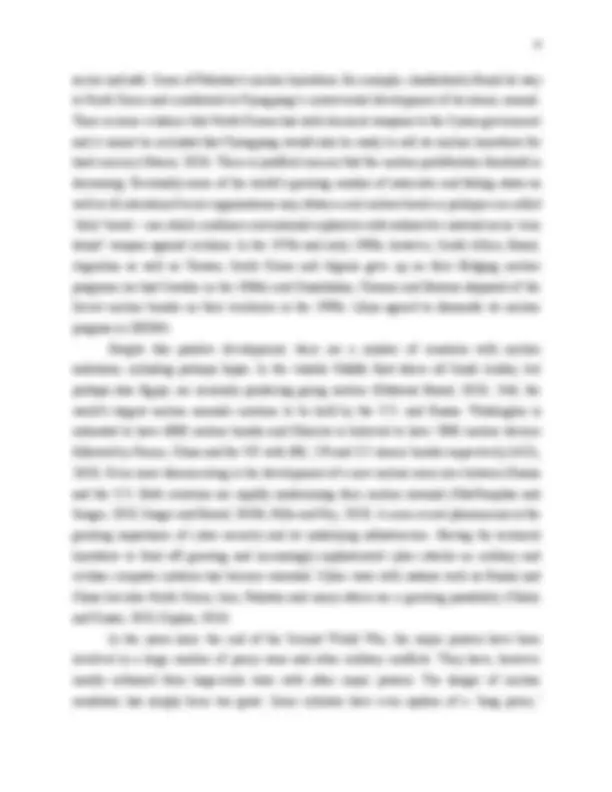
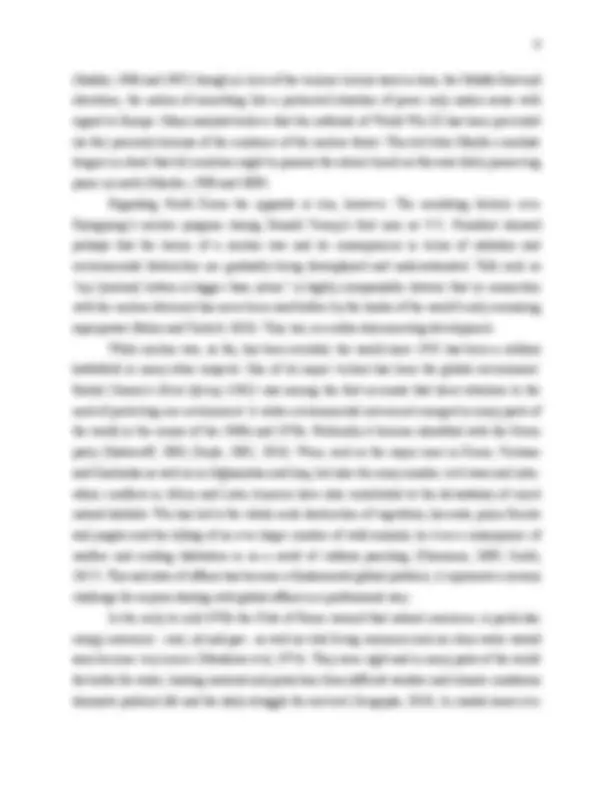
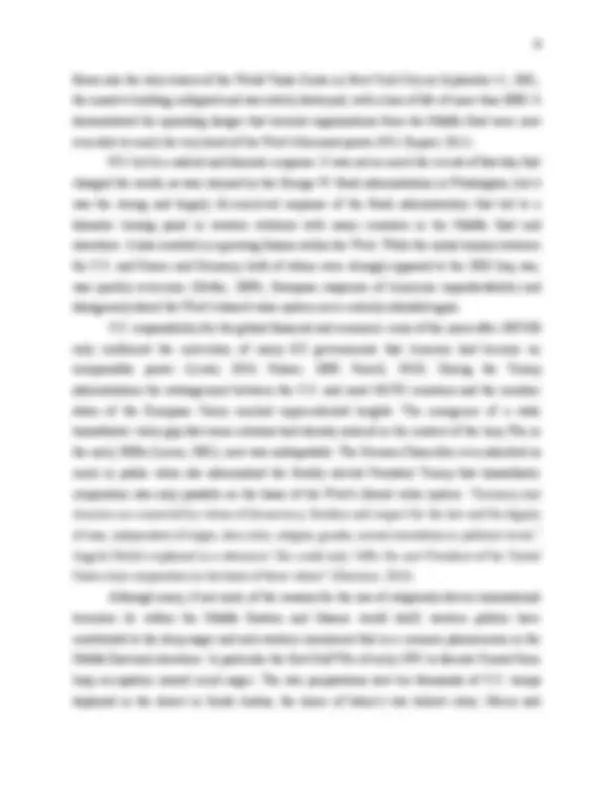
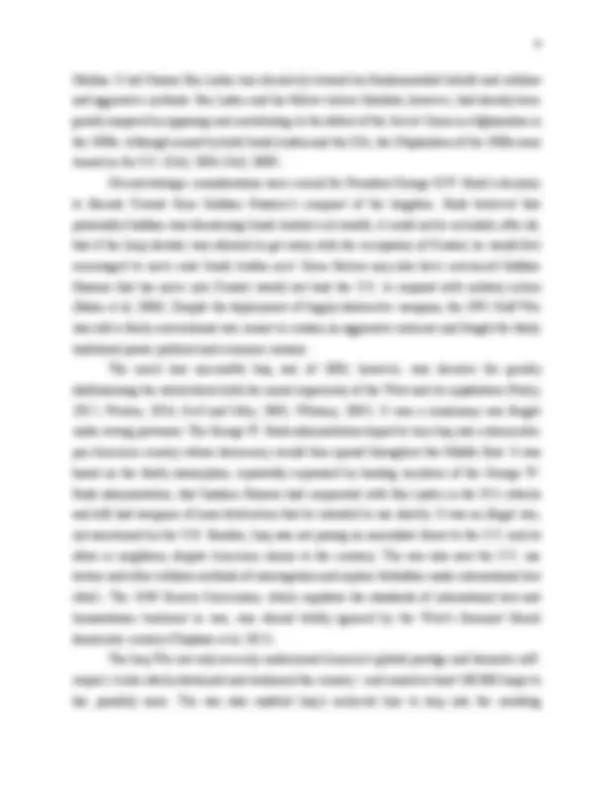
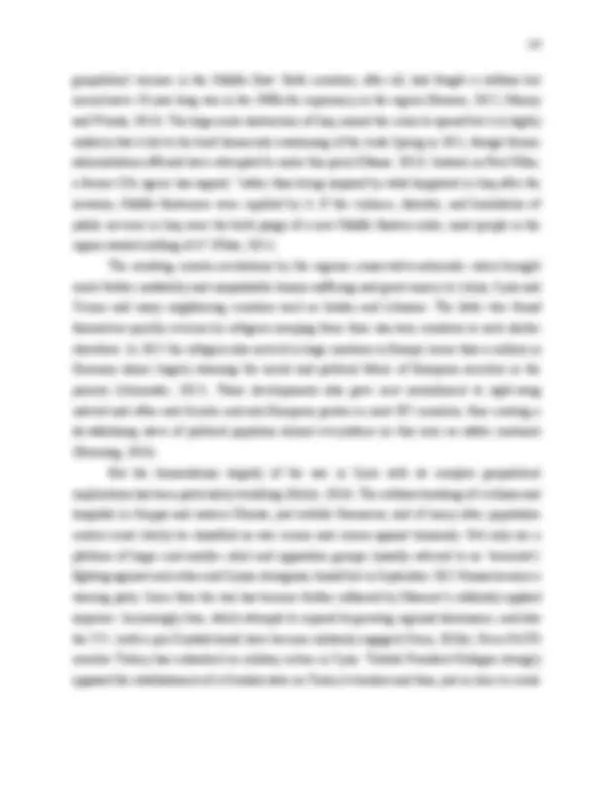
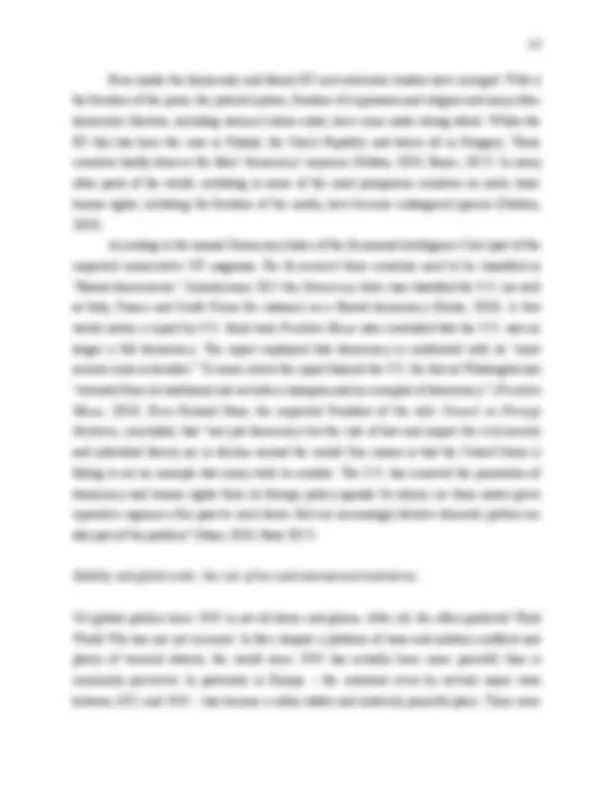
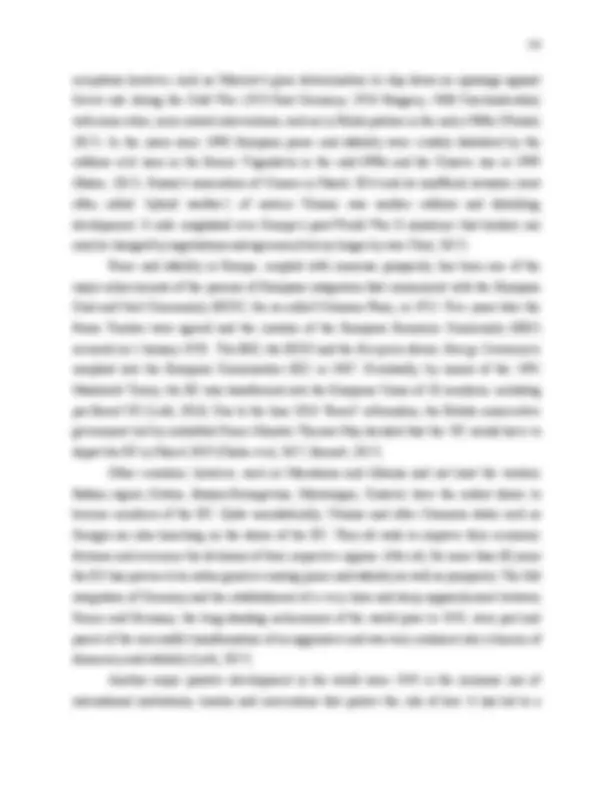
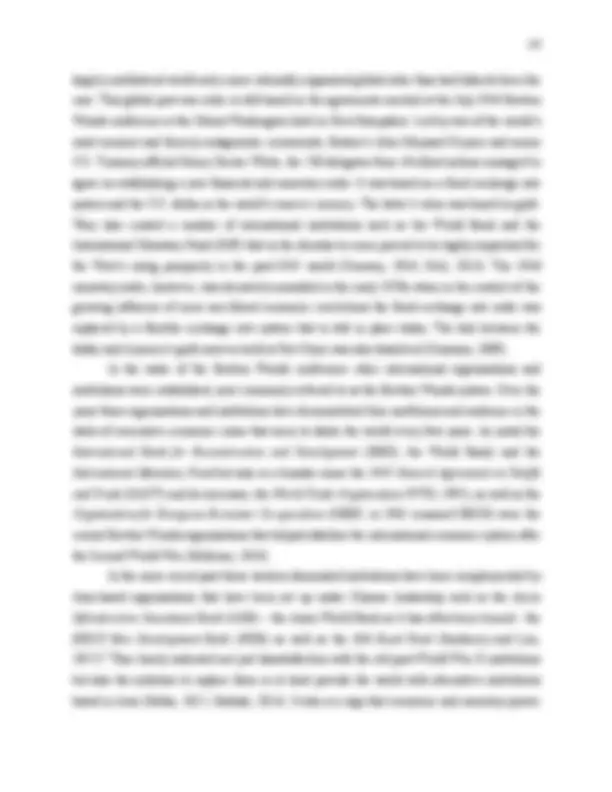
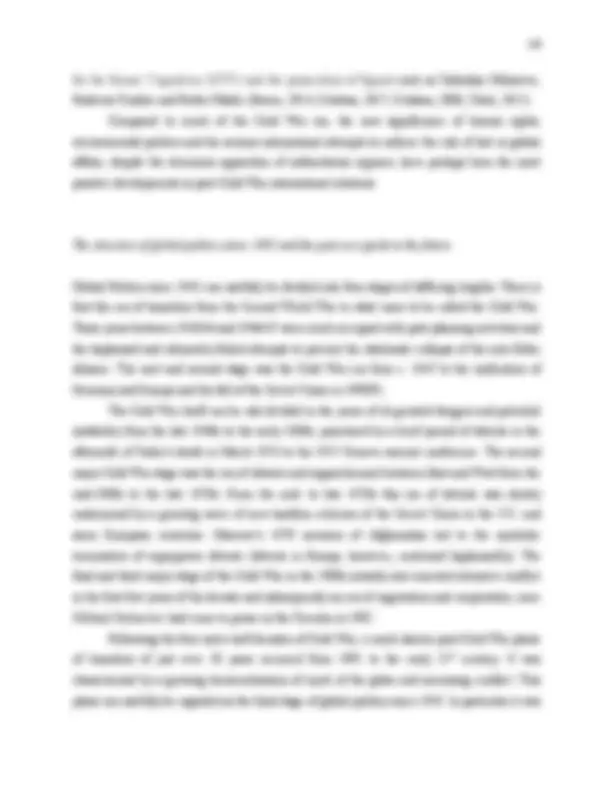
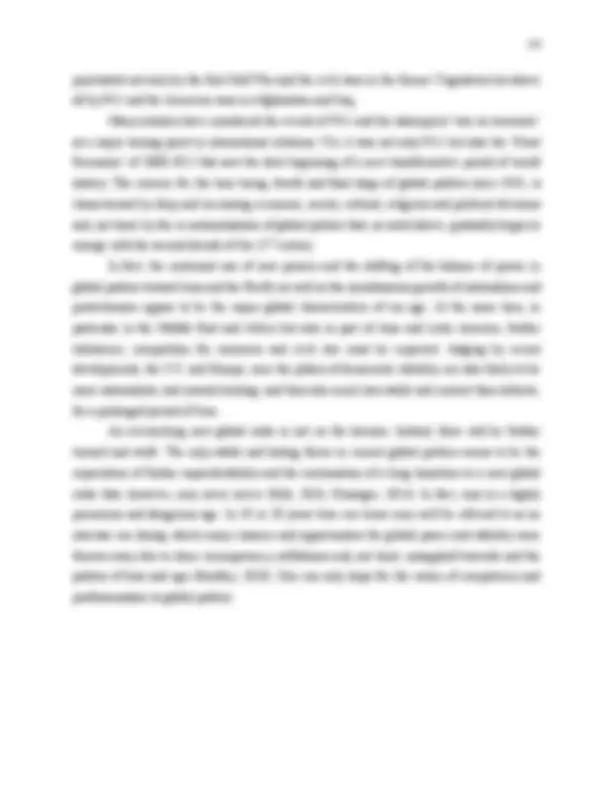

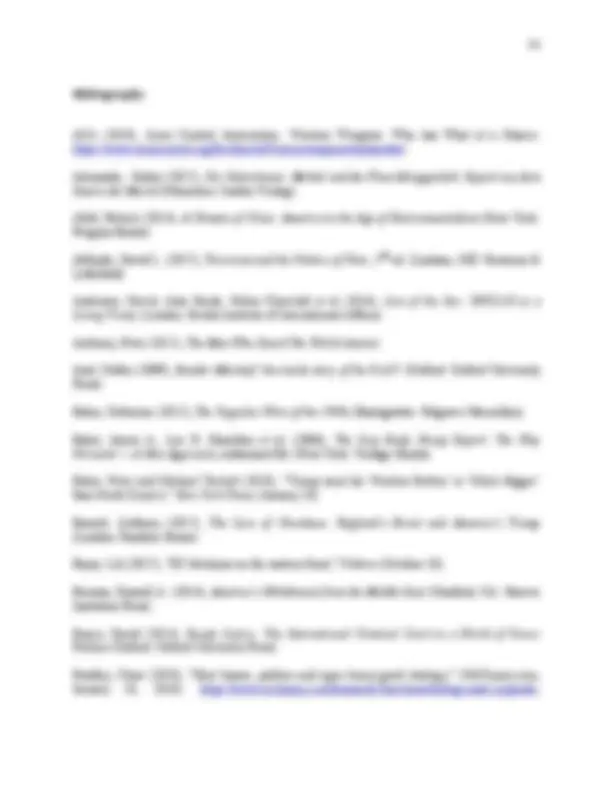
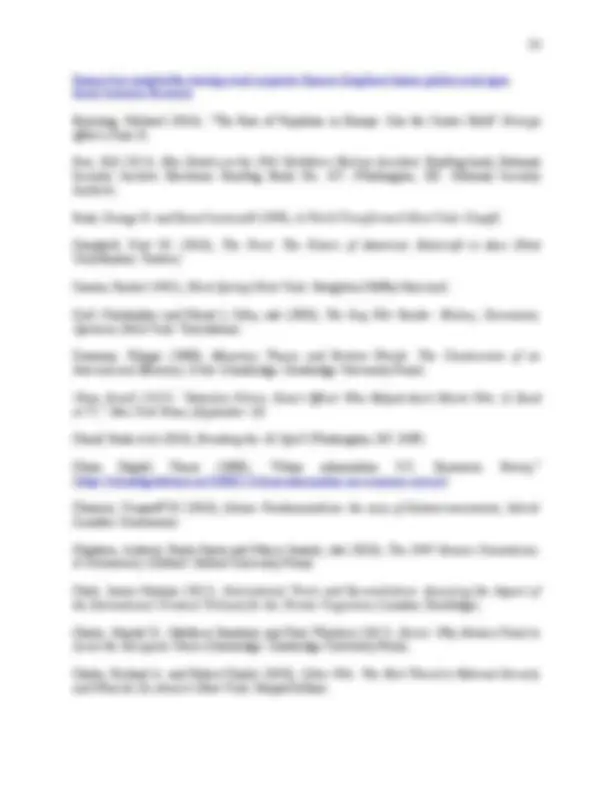
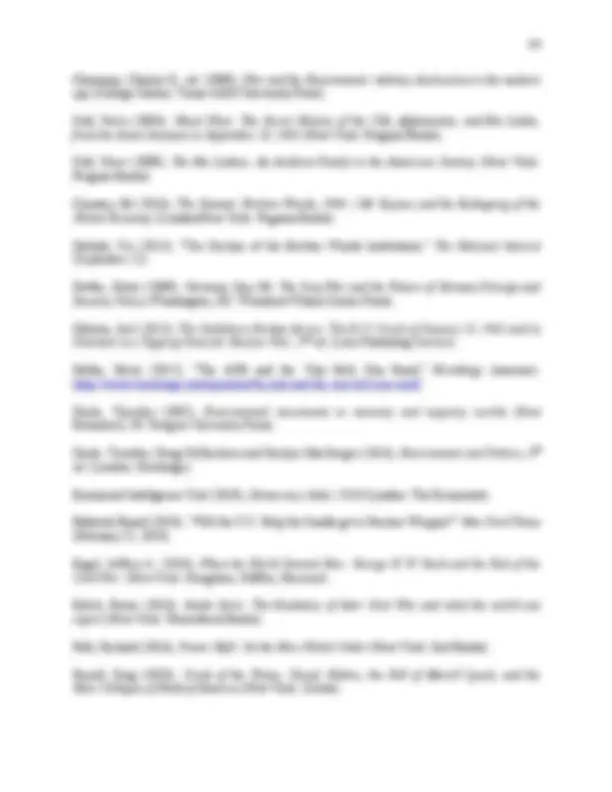
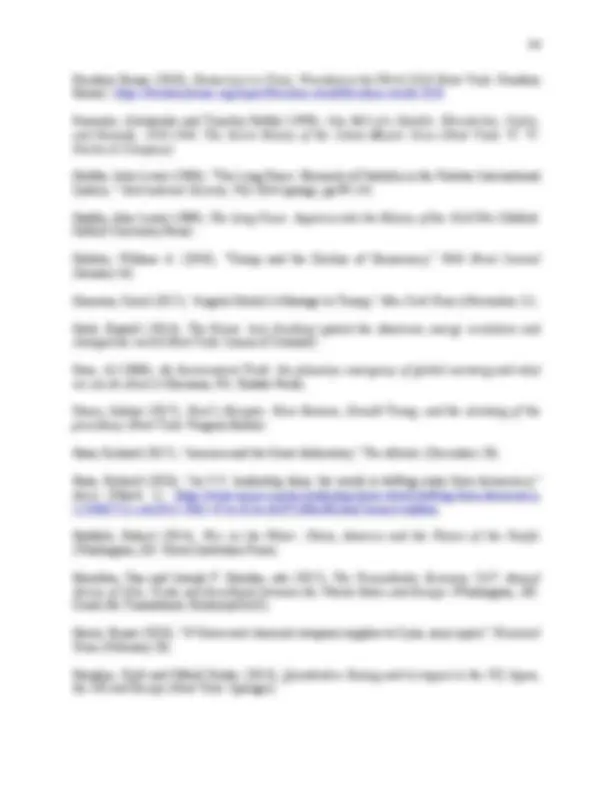
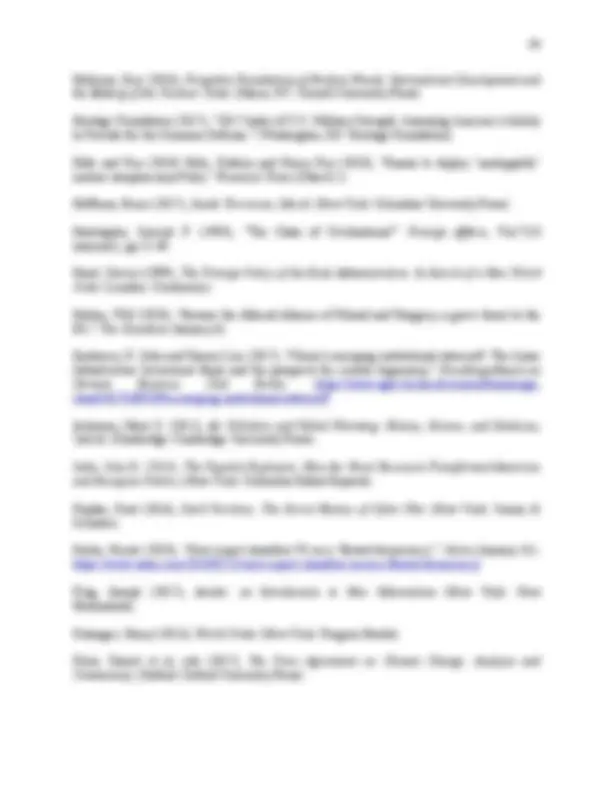
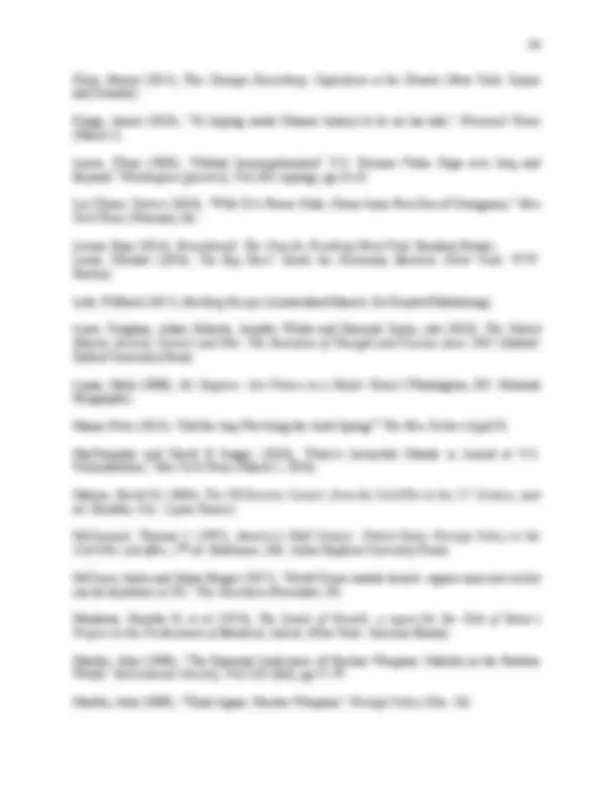
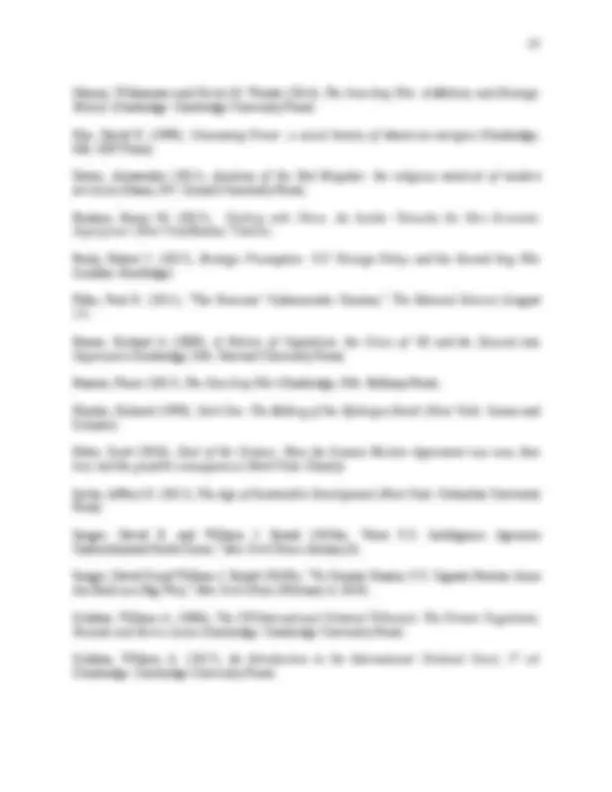
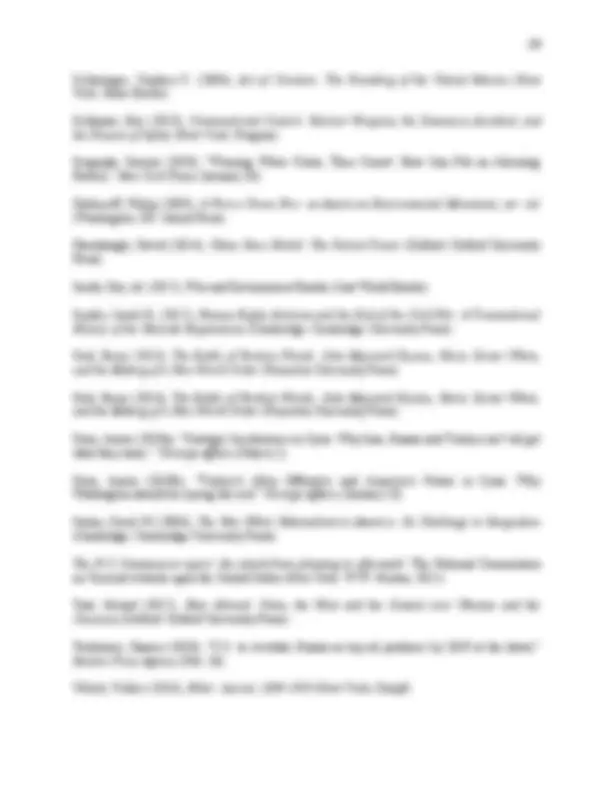
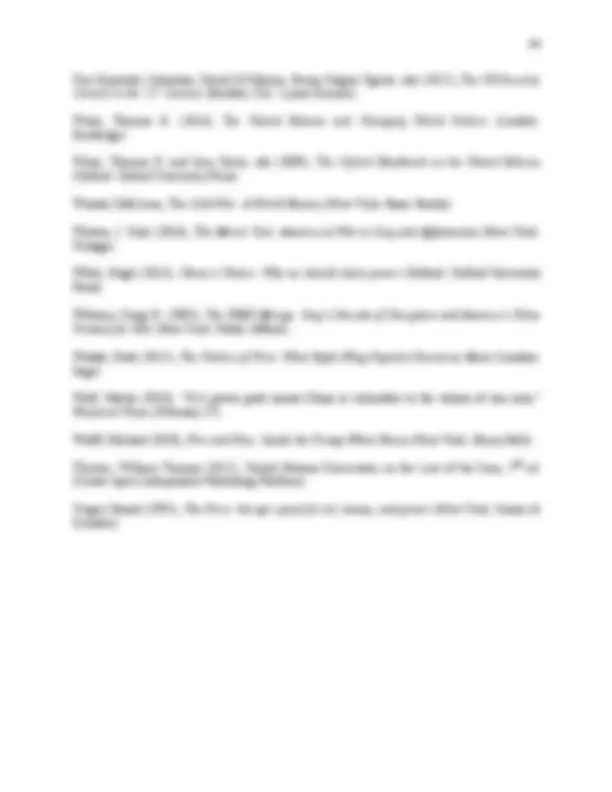




Study with the several resources on Docsity

Earn points by helping other students or get them with a premium plan


Prepare for your exams
Study with the several resources on Docsity

Earn points to download
Earn points by helping other students or get them with a premium plan
Community
Ask the community for help and clear up your study doubts
Discover the best universities in your country according to Docsity users
Free resources
Download our free guides on studying techniques, anxiety management strategies, and thesis advice from Docsity tutors
International Relations description of Nation and State
Typology: Lecture notes
1 / 31

This page cannot be seen from the preview
Don't miss anything!
























Chapter 1 Global Politics since 1945 Klaus Larres Forthcoming in: Klaus Larres and Ruth Wittlinger (eds), Understanding Global Politics: Actors and Themes in International Affairs (Routledge, 2019), chapter 1. It has been quite a rollercoaster. Global Politics since 1945 has never been boring though the post-World War II era has constituted a highly dangerous and deeply divided era. There was a short moment of unity and talk about a constructive new world order in the aftermath of the fall of the Berlin Wall in November 1989 and the disintegration of the Soviet Union in late 1991 (Bush and Scowcroft, 1998; Hurst, 1999; Engel, 2018). Altogether, however, the post-Cold War years have been quite unsettling. While East-West divisions have been overcome in geographical and strictly ideological ways, thinking along lines of ‘us’ and ‘them’ is alive and kicking. The world is still deeply divided. In terms of politics, religion, race, ethnicity as well as prosperity, demographic trends and, not least, questions of migration and immigration an unbridgeable gulf seems to exit in many parts of the globe. The 21 st century is also turning increasingly nationalistic. The world has become much more inward looking and self-focused than was the case in the preceding half-century (McCormick, 1989). The forces of globalization and integration have been on the defensive since at least the second decade of the 21st^ century. The memory of the violent and destructive consequences of the irresponsibly nationalistic 1930s and 1940s seem to have faded away (Ullrich, 2017). Yet, it was the violence, genocide and wholesale destruction wielded during those dark days that led to the global orientation of the years since 1945. In our multi-faceted and diverse world it is almost impossible to find a number of overarching developments that are characteristic for the entire era since 1945. Still, a number of
long-term features can be identified, some negative and quite disturbing ones as well as several much more positive and visionary factors. The former include the potential of sudden annihilation by nuclear weapons and the on-going step-by-step environmental destruction of the world as we know it. Other decisive forces of destruction with a long-term legacy have been transnational terrorism, the Iraq War of 2003 and the ‘Great Recession’ a few yeas later. Fortunately the post-1945 era has also been characterized by at least two crucial positive aspects: the rise of relative stability and integration in formerly deeply divided regions and the growing and beneficial importance of the rule of law and international institutions in global politics. This essay will elaborate on these aspects before then also outlining some likely trajectories for the future of global politics in the 21 st century. Forces of Destruction and Annihilation It was only less than 80 years ago that two atomic bombs destroyed the Japanese cities of Hiroshima and Nagasaki in August 1945. Ever since the nuclear threat and thus the destruction of the entire planet has been the ever present danger that has accompanied world politics since the end of the Second World War (Rhodes, 1996). Not only the 1962 Cuban Missile crisis (Fursenko and Naftali, 1996) but also quite a few other accidents and miscommunications brought the world close to a nuclear holocaust. An unexploded nuclear bomb is still buried deep in a field near the small town of Faro in the U.S. state of North Carolina. The B-52 that was carrying two 3 or 4 Megaton H-bombs broke up in mid-air and dropped its payload, almost leading to the detonation of the bombs. Only one of the bombs has been recovered (Dobson, 2013; Burr, 2014). Many similar nuclear accidents in the U.S. and elsewhere have become known to the wider public, not least due to the investigative work of journalists and political historians (Schlosser, 2014). With the growing number of nuclear powers during the Cold War and since, it has become increasingly likely that something might go wrong, be it for political-military or technical reasons or for reasons of miscommunication. In September 1983, for instance, at a time when superpower relations had hit rock bottom, the alarm went off at the secret command center in Moscow that monitored the country’s early warning satellite system. It appeared that the U.S. had launched five nuclear missiles that would hit the Soviet Union within twenty-five minutes.
secure and safe. Some of Pakistan’s nuclear knowhow, for example, clandestinely found its way to North Korea and contributed to Pyongyang’s controversial development of its atomic arsenal. There is some evidence that North Korean has sold chemical weapons to the Syrian government and it cannot be excluded that Pyongyang would also be ready to sell its nuclear knowhow for hard currency (Harris, 2018). There is justified concern that the nuclear proliferation threshold is decreasing. Eventually some of the world’s growing number of autocratic and failing states as well as ill-intentioned terror organizations may obtain a real nuclear bomb or perhaps a so-called ‘dirty’ bomb – one which combines conventional explosives with radioactive material as an ‘area denial’ weapon against civilians. In the 1970s and early 1980s, however, South Africa, Brazil, Argentina as well as Taiwan, South Korea and Algeria gave up on their fledging nuclear programs (as had Sweden in the 1960s) and Kazakhstan, Ukraine and Belarus disposed of the Soviet nuclear bombs on their territories in the 1990s. Libya agreed to dismantle its nuclear program in 2003/0 4. Despite this positive development, there are a number of countries with nuclear ambitions, including perhaps Japan. In the volatile Middle East above all Saudi Arabia, but perhaps also Egypt, are seriously pondering going nuclear (Editorial Board, 2018). Still, the world’s largest nuclear arsenals continue to be held by the U.S. and Russia. Washington is estimated to have 6800 nuclear bombs and Moscow is believed to have 7000 nuclear devices followed by France, China and the UK with 300, 270 and 215 atomic bombs respectively (ACA, 2018). Even more disconcerting is the development of a new nuclear arms race between Russia and the U.S. Both countries are rapidly modernizing their nuclear arsenals (MacFarquhar and Sanger, 2018; Sanger and Broad, 2018b; Hille and Foy, 2018). A more recent phenomenon is the growing importance of cyber security and its underlying infrastructure. Having the technical knowhow to fend off growing and increasingly sophisticated cyber attacks on military and civilian computer systems has become essential. Cyber wars with nations such as Russia and China but also North Korea, Iran, Pakistan and many others are a growing possibility (Clarke and Knake, 2010; Kaplan, 2016). In the years since the end of the Second World War, the major powers have been involved in a large number of proxy wars and other military conflicts. They have, however mostly refrained from large-scale wars with other major powers. The danger of nuclear escalation has simply been too great. Some scholars have even spoken of a ‘long peace,’
(Gaddis, 1986 and 1987) though in view of the various vicious wars in Asia, the Middle East and elsewhere, the notion of something like a protracted situation of peace only makes sense with regard to Europe. Many analysts believe that the outbreak of World War III has been prevented (so far) precisely because of the existence of the nuclear threat. This led John Mueller conclude tongue-in-cheek that all countries ought to possess the atomic bomb as this was likely preserving peace on earth (Mueller, 1988 and 2009). Regarding North Korea the opposite is true, however. The escalating rhetoric over Pyongyang’s nuclear program during Donald Trump’s first year as U.S. President showed perhaps that the horror of a nuclear war and its consequences in terms of radiation and environmental destruction are gradually being downplayed and underestimated. Talk such as “my [nuclear] button is bigger than yours,” is highly irresponsible rhetoric that in connection with the nuclear deterrent has never been used before by the leader of the world’s only remaining superpower (Baker and Tackett, 2018). This, too, is a rather disconcerting development. While nuclear war, so far, has been avoided, the world since 1945 has been a ruthless battlefield in many other respects. One of its major victims has been the global environment. Rachel Carson’s Silent Spring (1962) was among the first accounts that drew attention to the need of protecting our environment. A wider environmental movement emerged in many parts of the world in the course of the 1960s and 1970s. Politically it became identified with the Green party (Shabecoff, 2003; Doyle, 2005, 2016). Wars, such as the major ones in Korea, Vietnam and Cambodia as well as in Afghanistan and Iraq, but also the many smaller civil wars and intra- ethnic conflicts in Africa and Latin America have also contributed to the devastation of much natural habitats. War has led to the whole scale destruction of vegetation, harvests, prime forests and jungles and the killing of an ever larger number of wild animals, be it as a consequence of warfare and eroding habitation or as a result of ruthless poaching (Closmann, 2009; Smith, 2017). This sad state of affairs has become a fundamental global problem; it represents a serious challenge for anyone dealing with global affairs in a professional way. In the early to mid-1970s the Club of Rome warned that natural resources, in particular energy resources - coal, oil and gas - as well as vital living resources such as clean water would soon become very scarce (Meadows et al, 1974). They were right and in many parts of the world the battle for water, heating material and protection from difficult weather and climate conditions dominate political life and the daily struggle for survival (Sengupta, 2018). In coastal areas ever
perhaps began in earnest during the Obama administration and has continued under his successor, is certainly influenced by the diminishing oil importance of the region. In fact, by 2019 at the latest the U.S. will have become the world’s leading oil producer and exporter, well ahead of Russia and Saudi Arabia (Tsukimori, 201 8 ). This is a dramatic and entirely unexpected development. Still, the violence and political chaos in the region also plays a role for U.S. disinterest. Ignoring U.S. responsibility for contributing to the creation of these conditions in the first place, administrations from Bush to Obama and Trump became frustrated about their inability to contain the turmoil and gradually began to disengage America from the whole region (Berman, 2014). Transnational terrorism, war and economic distress The world since 1945 has seen a tremendous increase of both religious movements, particularly among Evangelicals and Islamists, and global terrorism. It is therefore tempting to believe in a causal link between the two. Thus, in the 21 st century transnational terrorism has frequently become identified in people’s mind with fundamentalist religious developments. For many Harvard scholar Samuel Huntington’s 1993 thesis of a coming ‘clash of civilizations’ appears to have become true. In fact it is a comparatively recent phenomenon that religious fundamentalism and transnational terrorism have entered into an unholy alliance. In contemporary global politics terrorism first became a well-known and quite secular phenomenon of western societies in the 1970s. Left-wing niche groups, such as the Red Brigades in Italy and the Baader-Meinhof gang in West Germany, began attacking establishment figures who they considered as symbols of fascist-leaning oppressive capitalist societies. Their activities culminated in the kidnapping and killing of Italian Prime Minister Aldo Moro and the head of West Germany’s employers’ association, Hanns Martin Schleyer (Orsini, 2011; Aust, 2009). Since the 1979 Iranian revolution and the emergence of a great number of fundamentalist Islamist movements in the decades since, transnational terrorism has gradually developed a strongly political and cultural anti-western direction. Terrorist groups such as Al Qaida and a decade later the Islamic State (ISIS) were frequently but not exclusively based in a number of Middle Eastern and African regions and states that had strong links with extreme Islamist movements and their missionary drives (Choueiri, 2010; Hoffman, 2017). When two planes were
flown into the twin towers of the World Trade Center in New York City on September 11, 2001, the massive building collapsed and was utterly destroyed, with a loss of life of more than 3000. It demonstrated the spreading danger that terrorist organizations from the Middle East were now even able to reach the very heart of the West’s foremost power (9/11 Report, 2011). 9/11 led to a radical and dramatic response. It was not so much the events of that day that changed the world, as was claimed by the George W. Bush administration in Washington, but it was the strong and largely ill-conceived response of the Bush administration that led to a dramatic turning point in western relations with many countries in the Middle East and elsewhere. It also resulted in a growing fission within the West. While the initial tension between the U.S. and France and Germany, both of whom were strongly opposed to the 2003 Iraq war, was quickly overcome (Dettke, 2009), European suspicion of American unpredictability and disingenuity about the West’s shared value system never entirely subsided again. U.S. responsibility for the global financial and economic crisis of the years after 2007/ only confirmed the conviction of many EU governments that America had become an irresponsible power (Lewis, 2010; Posner, 2009; Farrell, 2010 ). During the Trump administration the estrangement between the U.S. and most NATO countries and the member states of the European Union reached unprecedented heights. The emergence of a wide transatlantic value gap that some scholars had already noticed in the context of the Iraq War in the early 2000s (Larres, 2002), now was undisputable. The German Chancellor even admitted as much in public when she admonished the freshly elected President Trump that transatlantic cooperation was only possible on the basis of the West’s liberal value system. “Germany and America are connected by values of democracy, freedom and respect for the law and the dignity of man, independent of origin, skin color, religion, gender, sexual orientation or political views,” Angela Merkel explained in a statement. She could only “offer the next President of the United States close cooperation on the basis of these values” (Giacomo, 2016). Although many, if not most, of the reasons for the rise of religiously driven transnational terrorism lie within the Middle Eastern and Islamic world itself, western politics have contributed to the deep anger and anti-western resentment that is a common phenomenon in the Middle East and elsewhere. In particular the first Gulf War of early 1991 to liberate Kuwait from Iraqi occupation caused much anger. The war preparations saw ten thousands of U.S. troops deployed in the desert in Saudi Arabia, the home of Islam’s two holiest cities, Mecca and
geopolitical vacuum in the Middle East. Both countries, after all, had fought a ruthless but inconclusive 10-year long war in the 1980s for supremacy in the region (Razoux, 2015; Murray and Woods, 2014). The large-scale destruction of Iraq caused the crisis to spread but it is highly unlikely that it led to the brief democratic awakening of the Arab Spring in 2011, though former administration officials have attempted to make this point (Maass, 2013). Instead, as Paul Pillar, a former CIA agent, has argued, “rather than being inspired by what happened in Iraq after the invasion, Middle Easterners were repelled by it. If the violence, disorder, and breakdown of public services in Iraq were the birth pangs of a new Middle Eastern order, most people in the region wanted nothing of it” (Pillar, 2011). The resulting counter-revolutions by the regions conservative-autocratic rulers brought much further instability and unspeakable human suffering and great misery to Libya, Syria and Yemen and many neighboring countries such as Jordan and Lebanon. The latter two found themselves quickly overrun by refugees escaping from their war-torn countries to seek shelter elsewhere. In 2015 the refugees also arrived in huge numbers in Europe (more than a million in Germany alone) hugely straining the social and political fabric of European societies in the process (Alexander, 2015). These developments also gave new nourishment to right-wing nativist and often anti-Semitic and anti-European parties in most EU countries, thus creating a de-stabilizing wave of political populism almost everywhere on this once so stable continent (Broening, 2016). But the humanitarian tragedy of the war in Syria with its complex geopolitical implications has been particularly troubling (Erlich, 2016). The ruthless bombing of civilians and hospitals in Aleppo and eastern Ghouta, just outside Damascus, and of many other population centers must clearly be classified as war crimes and crimes against humanity. Not only are a plethora of larger and smaller rebel and opposition groups (usually referred to as ‘terrorists’) fighting against each other and Syrian strongman Assad but in September 2015 Russia became a warring party. Since then the war has become further inflamed by Moscow’s ruthlessly applied airpower. Increasingly Iran, which attempts to expand its growing regional dominance, and also the U.S. (with a pro-Kurdish bend) have become militarily engaged (Stein, 2018a). Even NATO member Turkey has embarked on military action in Syria. Turkish President Erdogan strongly opposed the establishment of a Kurdish state on Turkey’s borders and thus, just in time to create
nationalistic fervor in Turkey shortly before imminent elections, found himself in stark confrontation with Washington (Stein, 2018b). In short, the 2003 Iraq War and its terrible legacy in the Middle East have been responsible for undermining the standing of the U.S. as the global and often benign and enlightened superpower that the world had come to know since 1945. Furthermore, the global and financial overreach of the Bush administration and its loosening of the regulations that governed the behavior of banks and other financial institutions in the U.S. resulted in the global economic and financial crisis of 2008-12. From the U.S. the crisis spread to Europe and to many other parts of the world almost bringing down the globe’s entire complex financial framework. Only the enormous printing of money (‘quantitative easing’) in the U.S., China, the UK and soon also by the European Central Bank in Frankfurt prevented a wholesale collapse and the repetition of a 1929-style global Great Depression (Hausken and Ncube, 2013). Instead a ‘Great Recession’ arrived which was not nearly as calamitous in global terms; yet for the millions of individuals affected it proved to be almost as heart wrenchingly devastating. It was not only America’s European allies whose faith in U.S. leadership in global economic affairs was undermined by the crisis. China was even more profoundly disappointed, perhaps because Beijing still had an elevated idea of American ‘greatness’ and competency. The Chinese authorities made U.S. “excessive consumption and high leverage” responsible for the crisis and admonished Washington to ”speed up domestic adjustment, raise its savings and reduce its trade and fiscal deficits” ( China Digital Times, 2008). At the height of the financial crisis Politburo member Wang Qishan, one of only four Vice-Prime Ministers and the country’s leading economic expert, told Treasury Secretary Henry Paulson, who at the time was busy putting pressure on Beijing to open up its banking and economic system: “You were my teacher but look at your system, Hank, we aren’t sure we should be learning from you any more” (Paulson, 2015, p.240). The legacy of the painful economic, housing and employment crisis of the ‘Great Recession’ in the U.S. caused a dramatic rise of protective and semi-isolationist sentiments in many parts of the U.S., particularly in ‘fly-over-country’ in the Mid-West. A new era of nationalism emerged that was directed against anything loosely connected with ‘globalization,’ including America’s rich culture of immigration (Swain, 2004; Green, 2017; King, 2017). Paradoxically this backlash against globalization and against anyone who seemed to benefit from
Even inside the democratic and liberal EU new autocratic leaders have emerged. With it the freedom of the press, the judicial system, freedom of expression and religion and many other democratic liberties, including women’s dress codes, have come under strong attack. Within the EU this has been the case in Poland, the Czech Republic and above all in Hungary. These countries hardly deserve the label ‘democracy’ anymore (Hutton, 2018; Bayer, 2017). In many other parts of the world, including in some of the most prosperous countries on earth, basic human rights, including the freedom of the media, have become endangered species (Galston, 2018). According to the annual Democracy Index of the Economist Intelligence Unit (part of the respected conservative UK magazine The Economist ) these countries need to be classified as “flawed democracies.” Already since 2015 the Democracy Index has classified the U.S. (as well as Italy, France and South Korea for instance) as a flawed democracy (Karlis, 2018). A few weeks earlier a report by U.S. think tank Freedom House also concluded that the U.S. was no longer a full democracy. The report explained that democracy is confronted with its “most serious crisis in decades.” To some extent the report blamed the U.S. for this as Washington has “retreated from its traditional role as both a champion and an exemplar of democracy.” ( Freedom House , 2018). Even Richard Haas, the respected President of the elite Council on Foreign Relations , concluded, that “not just democracy but the rule of law and respect for civil society and individual liberty are in decline around the world. One reason is that the United States is failing to set an example that many wish to emulate. The U.S. has removed the promotion of democracy and human rights from its foreign policy agenda. Its silence on these issues gives repressive regimes a free pass to crack down. But our increasingly divisive domestic politics are also part of the problem” (Haas, 2018; Haas 2017). Stability and global order: the rule of law and international institutions Yet global politics since 1945 is not all doom and gloom. After all, the often-predicted Third World War has not yet occurred. In fact, despite a plethora of wars and military conflicts and plenty of terrorist attacks, the world since 1945 has actually been more peaceful than is commonly perceived. In particular in Europe – the continent riven by several major wars between 1871 and 1945 – has become a rather stable and relatively peaceful place. There were
exceptions however, such as Moscow’s grim determination to clap down on uprisings against Soviet rule during the Cold War (1953 East Germany, 1956 Hungary, 1968 Czechoslovakia) with some other, more muted interventions, such as in Polish politics in the early 1980s (Westad, 2017). In the years since 1990 European peace and stability were crudely disturbed by the ruthless civil wars in the former Yugoslavia in the mid-1990s and the Kosovo war in 1999 (Baker, 2015). Russia’s annexation of Crimea in March 2014 and its unofficial invasion (now often called ‘hybrid warfare’) of eastern Ukraine was another ruthless and disturbing development. It rode roughshod over Europe’s post-World War II insistence that borders can only be changed by negotiations and agreement but no longer by war (Toal, 2017). Peace and stability in Europe, coupled with immense prosperity, has been one of the major achievements of the process of European integration that commenced with the European Coal and Steel Community (ECSC; the so-called Schuman Plan), in 1952. Five years later the Rome Treaties were agreed and the creation of the European Economic Community (EEC) occurred on 1 January 1958. The EEC, the ECSC and the European Atomic Energy Commission morphed into the European Communities (EC) in 1967. Eventually, by means of the 1991 Maastricht Treaty, the EC was transformed into the European Union of 28 members, including pre-Brexit UK (Loth, 2016). Due to the June 2016 ‘Brexit’ referendum, the British conservative government led by embattled Prime Minister Theresa May decided that the UK would have to depart the EU in March 2019 (Clarke et al, 2017; Barnett, 2017). Other countries, however, such as Macedonia and Albania and not least the western Balkan region (Serbia, Bosnia-Herzegovina, Montenegro, Kosovo) have the ardent desire to become members of the EU. Quite unrealistically, Ukraine and other Caucasus states such as Georgia are also knocking on the doors of the EU. They all wish to improve their economic fortunes and overcome the divisions of their respective regions. After all, for more than 60 years the EU has proven to be rather good at creating peace and stability as well as prosperity. The full integration of Germany and the establishment of a very close and deep rapprochement between France and Germany, the long-standing archenemies of the world prior to 1945, were part and parcel of the successful transformation of an aggressive and war-torn continent into a beacon of democracy and stability (Loth, 2017). Another major positive development in the world since 1945 is the immense rise of international institutions, treaties and conventions that protect the rule of law. It has led to a
is increasingly shifting toward the Pacific. President Obama’s 2011 ‘pivot to Asia’ that emphasized U.S. re-engagement in the region did not delay or stop this development (Campbell, 2016). After all, since the 1990s China’s has come into its own and has rapidly risen to be the second most important country in the world, in terms of global trade, economics and increasingly also regarding global political influence. In fact, Beijing is actively challenging the U.S. for the top spot position (Shambaugh, 2014; White, 2013). Still, despite China and Asia’s rapid rise, at present most world trade is still transatlantic trade, however. More than 40 per cent of all global trade still occurs between the countries (mostly the US and the EU) on both sides of the Atlantic (Hamilton and Quinlan, 2017). Talk about a transatlantic trade war regarding the imposition of U.S. tariffs on steel, aluminum and other products, however, undermines transatlantic unity. At the same time most major companies in the U.S. and the EU are highly dependent for their profit margins on their markets in China. While in military terms there still is no country on earth that can rival America, although it might be eroding in the Pacific (Haddick, 2014; Heritage Foundation, 2017), in global economic and political-democratic terms, it appears, the U.S. is an embattled power with China being in the ascendant. This clearly is the view in Beijing. China’s ‘market authoritarianism,’ the country’s elite has concluded, is the model of the future. “Disorder in the West,” communist official Zhang Weiwei wrote, “has become a major source of global insecurity and instability” with “the western model now” encountering “grave challenges.” He made the distorting influence of money and capital in U.S. elections and politics responsible for this situation (Kynge, 2018). Xi JInping expressed a similar view of superiority when he explained in 2017 that China was offering “a new option to other countries and nations who want to speed up their development while preserving their independence” from western insistence on certain democratic and human rights norms they had to fulfill to obtain western support (ibid.). Perhaps, as Martin Wolf has argued in the Financial Times , “we are, once again, in an era of competition of systems” – and strategic rivalry – “between democratic and – strange though it may sound (and indeed is) – communist capitalism” (Wolf, 2018). The United Nations, established at the San Francisco conference in June 1945, and its many sub-organizations have also demonstrated their usefulness for global stability (and emergency military and humanitarian relief action (Schlesinger, 2004). The important UN
Security Council with its five permanent veto-possessing powers (U.S., Russia, China, the UK and France) and its temporary 10 members, selected on a two-year rotating basis, was paralyzed during much of the Cold War. But even during the Cold War both the Security Council and also the General Assembly proved to be important debating chambers in which member states could let off steam, talk to each other and, on occasion, hammer out preparatory deals for resolving a number of urgent crises. During the Cuban Missile Crisis, in the course of various great power clashes in the 1960s and 1970s as well as for instance during the run-up to the 2003 Iraq War, the UN proved to be an important instrument. Both vicious East-West clashes and, on occasion, intra-western disagreements occurred but also constructive cooperation for working out compromise solutions (Malone, 2004; Von Einsiedel et al, 2015; Lowe et al, 2010). Throughout the long war in Syria that began already in 2011, however, the UN proved to be rather ineffective. UN bodies and UN overseen conventions and norms have also been responsible for making the rule of law an increasingly important criteria in international affairs. This not only applies to human rights that became an ever more important part of international relations since the 1975 Helsinki conference. It was this conference that agreed on formally accepting the post- war borders in Europe as defined toward the end of World War II. At Helsinki the Soviet Union also signed off on the so-called Basket Three that focused on human rights. It soon became a rallying point for the proliferating dissenting movements in the Soviet bloc in the 1980s. It could be argued, therefore, that the Helsinki conference significantly contributed to bringing about the end of the Cold War (Snyder, 2013). It was under UN auspices that the development occurred of not only the 1949 Geneva convention referred to above but also of the global norm setting legal mechanisms of the post- war world (Weiss and Daws, 2009; Weiss, 2016). Part of these is is the complex court and tribunal system that has emerged from the 1982 treaty of the UN Convention on the Law of the Seas (UNCLOS) (Worster, 2012; Anderson and Boyle, 2016). Among the UN system’s most influential body is perhaps the International Criminal Court (ICC) based in The Hague, Netherlands. that is meant to complement national judicial systems; it began working in June
punctuated not only by the first Gulf War and the civil wars in the former Yugoslavia but above all by 9/11 and the American wars in Afghanistan and Iraq. Many scholars have considered the events of 9/11 and the subsequent ‘war on terrorism’ as a major turning point in international relations. Yet, it was not only 9/11 but also the ‘Great Recession’ of 2008- 2012 that saw the slow beginning of a new transformative period of world history. The current, for the time being, fourth and final stage of global politics since 1945, is characterized by deep and increasing economic, social, cultural, religious and political divisions and, not least, by the re-nationalization of global politics that, as noted above, gradually began to emerge with the second decade of the 21st^ century. In fact, the continued rise of new powers and the shifting of the balance of power in global politics toward Asia and the Pacific as well as the simultaneous growth of nationalism and protectionism appear to be the major global characteristics of our age. At the same time, in particular in the Middle East and Africa but also in part of Asia and Latin America, further turbulence, competition for resources and civil war must be expected. Judging by recent developments, the U.S. and Europe, once the pillars of democratic stability, are also likely to be more nationalistic and inward-looking, and thus also much less stable and content than hitherto, for a prolonged period of time. An overarching new global order is not on the horizon. Instead, there will be further turmoil and strife. The only stable and lasting factor in current global politics seems to be the expectation of further unpredictability and the continuation of a long transition to a new global order that, however, may never arrive (Falk, 2016; Kissinger, 2014). In fact, ours is a highly precarious and dangerous age. In 10 or 20 years time our times may well be referred to as an interwar era during which many chances and opportunities for global peace and stability were thrown away due to sheer incompetency, selfishness and, not least, misapplied bravado and the politics of bias and ego (Bradley, 2018). One can only hope for the return of competency and professionalism to global politics.
Further Reading: Calvocoressi, Peter, World Politics since 1945 , 9th^ ed. (Harlow, England: Pearson Longman, 2009). Herring, George, C, From Colony to Superpower: U.S. Foreign Relations since 1776 (New York/Oxford: Oxford University Press, 2008). Hunt, Michael H., The World Transformed: 1945 to the Present , 2nd^ ed. (New York/Oxford: Oxford University Press, 2016). Immerman, Richard H and Petra Goedde (eds), The Oxford Handbook of the Cold War (New York/Oxford: Oxford University Press, 2013). Keylor, William R., A World of Nations: The International Order since 1945 , 2nd^ ed. (New York/Oxford: Oxford University Press, 2009). Kissinger, Henry, World Order (New York: Penguin Books, 2014) Larres, Klaus (ed.), The Blackwell Companion to Europe since 1945 (Malden, MA/Oxford: Wiley Blackwell, 2009). McWilliams, Wayne C. and Harry Piotrowski, The World since 1945: A History of International Relations (Boulder, CO: Lynne Riener, 2009). Westad, Odd Arne, The Cold War: A World History (New York: Basic Books, 2017). Young, John W. and John Kent, International Relations since 1945 (New York/Oxford: Oxford University Press, 2004).